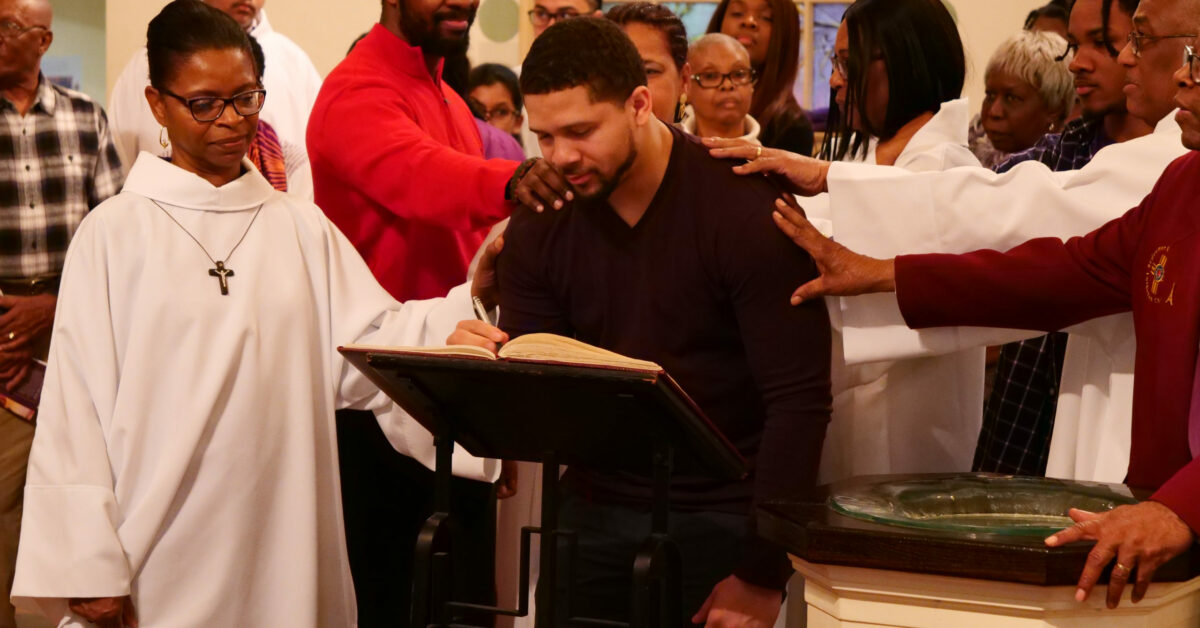A Ritual Journey: The Rite of Election
Ritually, the journey into the Period of Intense Preparation/Purification-Enlightenment happens with the Rite of Election on the First Sunday in Lent. It is a liminal crossing as the catechumens transition into those elected for baptism. From this point on they are preparing for baptismal incorporation into the full life of the church through the Rites of Initiation. The symbolic center of this rite (as also central to the Rites of Initiation) is the names of the elect and the community that affirms their readiness to pursue the path to baptism (Madigan, Liturgical Spirituality and the Rite of Christian Initiation of Adults, 52).
The rite is the culmination of a process of discernment by which the church (and the Holy Spirit through the church) discerns the catechumens’ readiness for baptism. There are a number of ways to envision discerning whether the catechumens are ready. Ronald Lewinski says that it entails discerning whether the Way of Jesus is becoming their way of life (Lewinski, An Introduction to the RCIA, 48). Shawn Madigan describes the discernment in biblical ways: “to be holy as the Lord your God is holy (Leviticus 19:2); “to do justice, and to love kindness and to walk humbly with your God” (Micah 6:8); or Jesus’ own words, “that you love one another: just as I have loved you, you also are to love one another. By this all people will know that you are my disciples, if you have love for one another” (John 13:34-35).
This process of discernment involves the catechumens, the sponsors, the catechumenate leader, the pastors, and the entire congregation. It starts within the catechumenate itself and culminates in the weeks and days leading to the Rite of Election (Lewinski, 49). The sponsors who know the catechumens well are critical to the process of discernment. Go Make Disciples provides a helpful list of questions to facilitate this discernment: “Has a catechumen been regular in attending worship and disciple-making sessions? Has the catechumen been developing a Christian identity? Does the catechumen know key biblical stories and feel comfortable with primary Christian teachings and practices? Has the catechumen pursued one or more forms of service to the larger community and world beyond?” (103). [Lewinski (48) has similar questions but nuanced differently]. In the end, as Madigan observes, this discernment is intended to allow the sponsors and the church to affirm for the elect that “Election and continuing conversion imply a life of Christian communion and mission” (Madigan, 53) for the elect personally.
So what does the Rite of Election look like? [It should be noted that in Roman Catholicism the Rite of Election is led by the bishop in the cathedral church and not in the local parish church.] Here is an outline from Go Make Disciples (105) which parallels the actual texts and rituals in Welcome to Christ (18-21) and also what is in the RCIA Study Edition (63-76):
- Presentation of the baptismal candidates
- Expression of desire to be baptized
- Questions of affirmation from the sponsors
- Congregation’s pledge of support to the elect
- Inscription of names (hopefully by the elect themselves) in the Book of the Elect
- Intercessory prayer for the elect
- Sending/Blessing of the elect
Neither the RCIA nor Welcome to Christ provide a question of affirmation by the assembly (see Guide for Celebrating Christian Initiation with Adults, 56, [hereafter Guide] for a helpful text) which would be helpful to include, since the assembly is the primary agent for incubating conversion to faith. In addition, the RCIA provides two more complete sets of intercessions for the elect, not represented in the much briefer (but certainly appropriate) prayers in Welcome to Christ.
A number of observations about ritual conduct of the Rite of Election are helpful. First, it is symbolically significant to have a substantive Book of the Elect (See Guide, 54) that can be placed someplace prominent, perhaps near the font or the paschal candle, throughout the seasons of Lent and Easter. The placement of the catechumens for the Rite should be arranged so that they and their sponsors are facing the assembly (see Guide, 55) since they (by name) and the assembly are the primary symbols in the rite. It is appropriate to link this rite and the Rite of Welcome/Acceptance with the catechumenate by using the same sung refrain at both. It might be used with each person being elected.
It is important that the elect reflect upon their election after it occurs. Go Make Disciples (109) includes these helpful questions for reflection:
- How did you experience the rite?
- Were you surprised by anything?
- Were you confused by anything?
- Is there anything that you wish could be explained?
Intersecting reflection on the experience with Scripture, especially the readings from the First Sunday in Lent, would be very helpful (see also Lewinski, 50).
The Rite of Election is a profoundly transformative experience as expressed in the blessing/sending from Welcome to Christ,
“Journey with us now through Lent as we prepare for the festival of our Lord’s death and resurrection. May God bring you in peace and joy to the day of your baptism and to fullness of life in Christ” (Welcome to Christ, 20).
